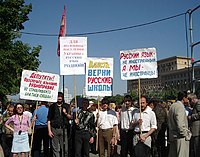
Photo from wikipedia
As we are writing this article, the President of the United States is meeting with the President of North Korea in Singapore and the heads of the G7 nations are… Click to show full abstract
As we are writing this article, the President of the United States is meeting with the President of North Korea in Singapore and the heads of the G7 nations are meeting in Canada. Members of these meetings speak a range of languages—English, Japanese, Italian, Korean, Spanish and French. As they make important decisions about trade and nuclear weapons they also choose what language to use when they negotiate these topics. The Special Issue that we introduce evaluates the relationship between these two types of choices through both empirical and theoretical perspectives. People’s decisions are affected by several factors supposedly irrelevant to the specific details of the decision making problem (e.g., Thaler, 2014). The time of day, the difficulty of an experience, the familiarity of the situation, and many others are factors than can affect our revealed preferences on everyday basis. We have recently discovered that the foreignness of the language people use affects their choices—people make systematically different decisions in a foreign language compared to their native tongue (Costa, Foucart, Arnon, Aparici, & Apesteguia, 2014; Keysar, Hayakawa, & An, 2012; see for reviews, Costa, Vives, & Corey, 2017; Hayakawa, Costa, Foucart, & Keysar, 2016). The discovery of the “foreign language effect” has produced different reactions from scholars in different fields. For instance, for researchers working on language processing and especially for those interested in bilingualism, the results have sparked curiosity and have been seen as a way to broaden the scope of their own research by linking psycholinguistic research, reasoning, and decision making. In other words, it has become another way to study the relationship between thought and language. For researchers interested in decision making, the phenomenon might seem as just another example of “supposedly” irrelevant factors affecting people’s decisions. We propose that this is not just another variable, but one that is crucial for understanding how people evaluate the options afforded by the decision making situation. We think this because language context is unavoidable when making a decision. That is, we are always embedded in a linguistic context, and for many of us such a context is often a foreign language one. It is in fact estimated that over 100 million citizens of the European Union, or about 25% of its population use at least one foreign language regularly (Special Eurobarometer, 2012). Many of us routinely buy products, order food, and even evaluate the merit of scientific projects in a language other than our native tongue. But the use of a foreign language as a communication tool goes well beyond science, tourism, or international trade. Certain languages have received the status of a lingua franca reaching global dimensions of usage in international meetings where far reaching decisions are commonly taken, such as at the meetings of the delegates of the North Atlantic Treaty Organisation (NATO). Hence, if we want to understand people’s judgements, revealed preferences, feelings, and choices, we must understand how language context shapes them. This enterprise is not an easy one because of at least two major challenges related to the features of foreign languages that may modulate their role in the interplay with decision making. The first one has to do with the fact that native and foreign language processing differs in many ways. Foreign language processing is usually slower and less fluent, induces higher cognitive load and elicits a lower emotional reactivity. To make things more difficult, all these factors have been shown to affect people’s choices and revealed preferences in decision-making contexts, and hence they might also contribute to the foreign language effect. Disentangling which of these factors are behind this phenomenon is one of the major challenges of this line of research. The second challenge relates to the definition of a foreign language and to the large variability of individual experiences with such a language. This variability is found Language context and decision-making: Challenges and advances
Journal Title: Quarterly Journal of Experimental Psychology
Year Published: 2019
Link to full text (if available)
Share on Social Media: Sign Up to like & get
recommendations!